FORD F350 2004 Owners Manual
Manufacturer: FORD, Model Year: 2004, Model line: F350, Model: FORD F350 2004Pages: 312, PDF Size: 2.89 MB
Page 161 of 312
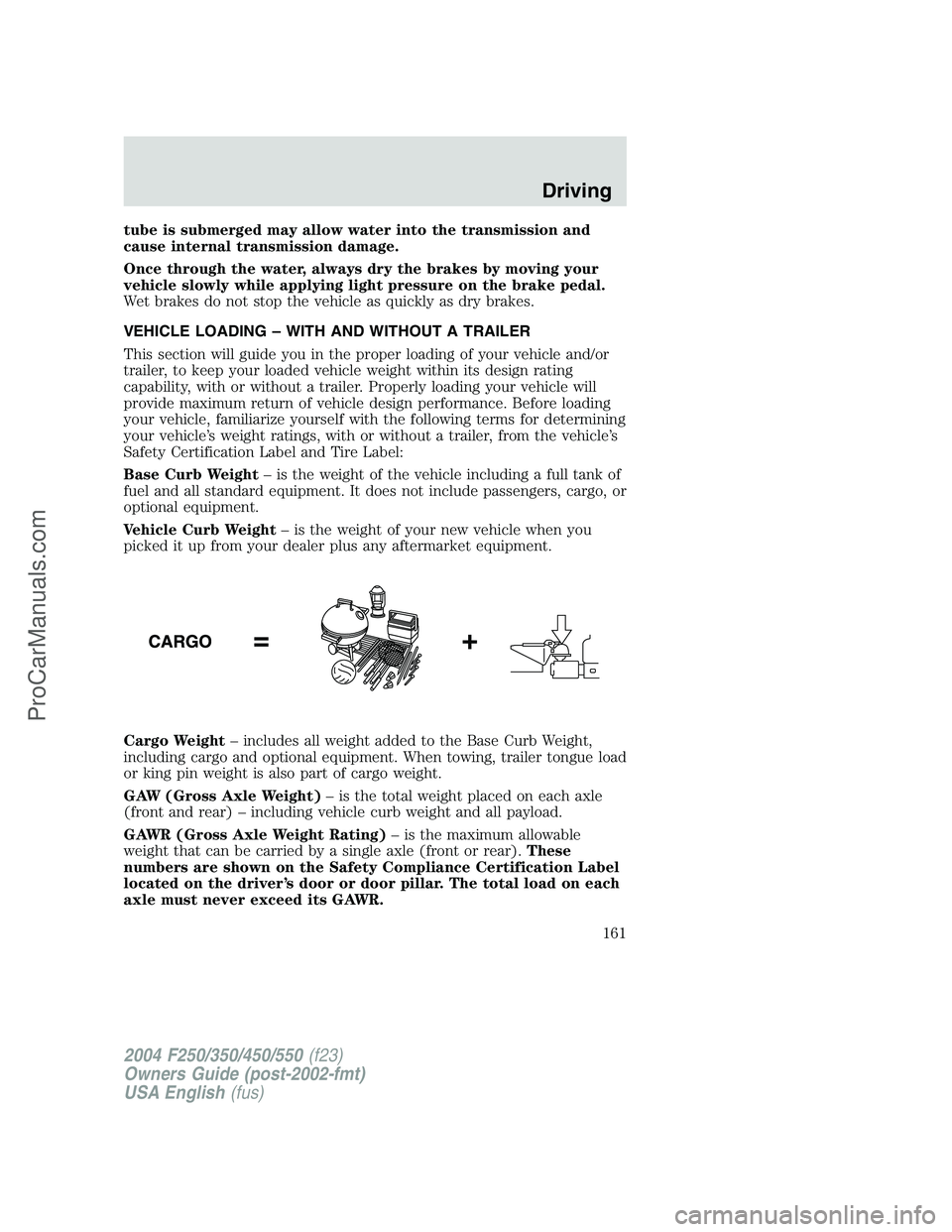
tube is submerged may allow water into the transmission and
cause internal transmission damage.
Once through the water, always dry the brakes by moving your
vehicle slowly while applying light pressure on the brake pedal.
Wet brakes do not stop the vehicle as quickly as dry brakes.
VEHICLE LOADING–WITH AND WITHOUT A TRAILER
This section will guide you in the proper loading of your vehicle and/or
trailer, to keep your loaded vehicle weight within its design rating
capability, with or without a trailer. Properly loading your vehicle will
provide maximum return of vehicle design performance. Before loading
your vehicle, familiarize yourself with the following terms for determining
your vehicle’s weight ratings, with or without a trailer, from the vehicle’s
Safety Certification Label and Tire Label:
Base Curb Weight–is the weight of the vehicle including a full tank of
fuel and all standard equipment. It does not include passengers, cargo, or
optional equipment.
Vehicle Curb Weight–is the weight of your new vehicle when you
picked it up from your dealer plus any aftermarket equipment.
Cargo Weight–includes all weight added to the Base Curb Weight,
including cargo and optional equipment. When towing, trailer tongue load
or king pin weight is also part of cargo weight.
GAW (Gross Axle Weight)–is the total weight placed on each axle
(front and rear)–including vehicle curb weight and all payload.
GAWR (Gross Axle Weight Rating)–is the maximum allowable
weight that can be carried by a single axle (front or rear).These
numbers are shown on the Safety Compliance Certification Label
located on the driver’s door or door pillar. The total load on each
axle must never exceed its GAWR.
2004 F250/350/450/550(f23)
Owners Guide (post-2002-fmt)
USA English(fus)
Driving
161
ProCarManuals.com
Page 162 of 312
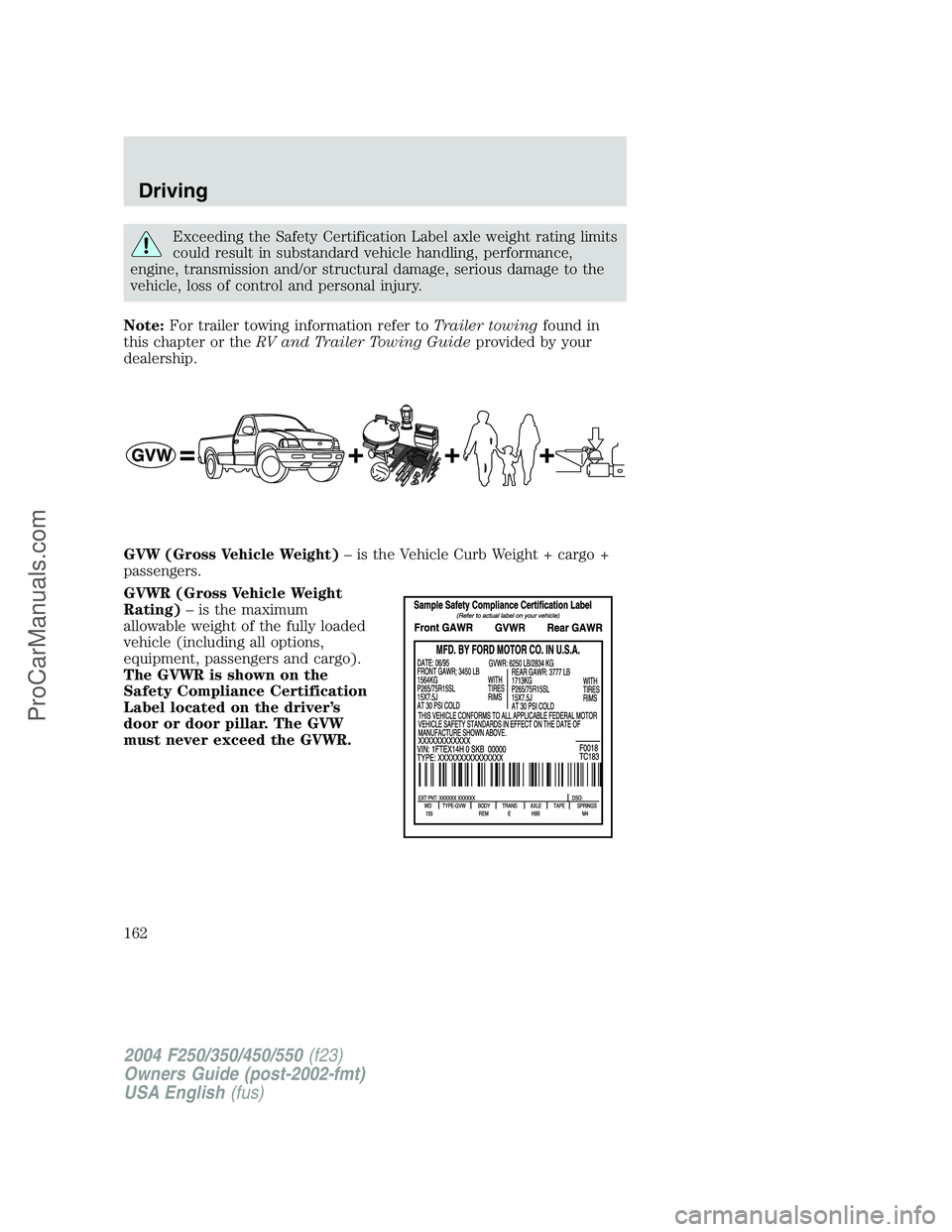
Exceeding the Safety Certification Label axle weight rating limits
could result in substandard vehicle handling, performance,
engine, transmission and/or structural damage, serious damage to the
vehicle, loss of control and personal injury.
Note:For trailer towing information refer toTrailer towingfound in
this chapter or theRV and Trailer Towing Guideprovided by your
dealership.
GVW (Gross Vehicle Weight)–is the Vehicle Curb Weight + cargo +
passengers.
GVWR (Gross Vehicle Weight
Rating)–is the maximum
allowable weight of the fully loaded
vehicle (including all options,
equipment, passengers and cargo).
The GVWR is shown on the
Safety Compliance Certification
Label located on the driver’s
door or door pillar. The GVW
must never exceed the GVWR.
2004 F250/350/450/550(f23)
Owners Guide (post-2002-fmt)
USA English(fus)
Driving
162
ProCarManuals.com
Page 163 of 312
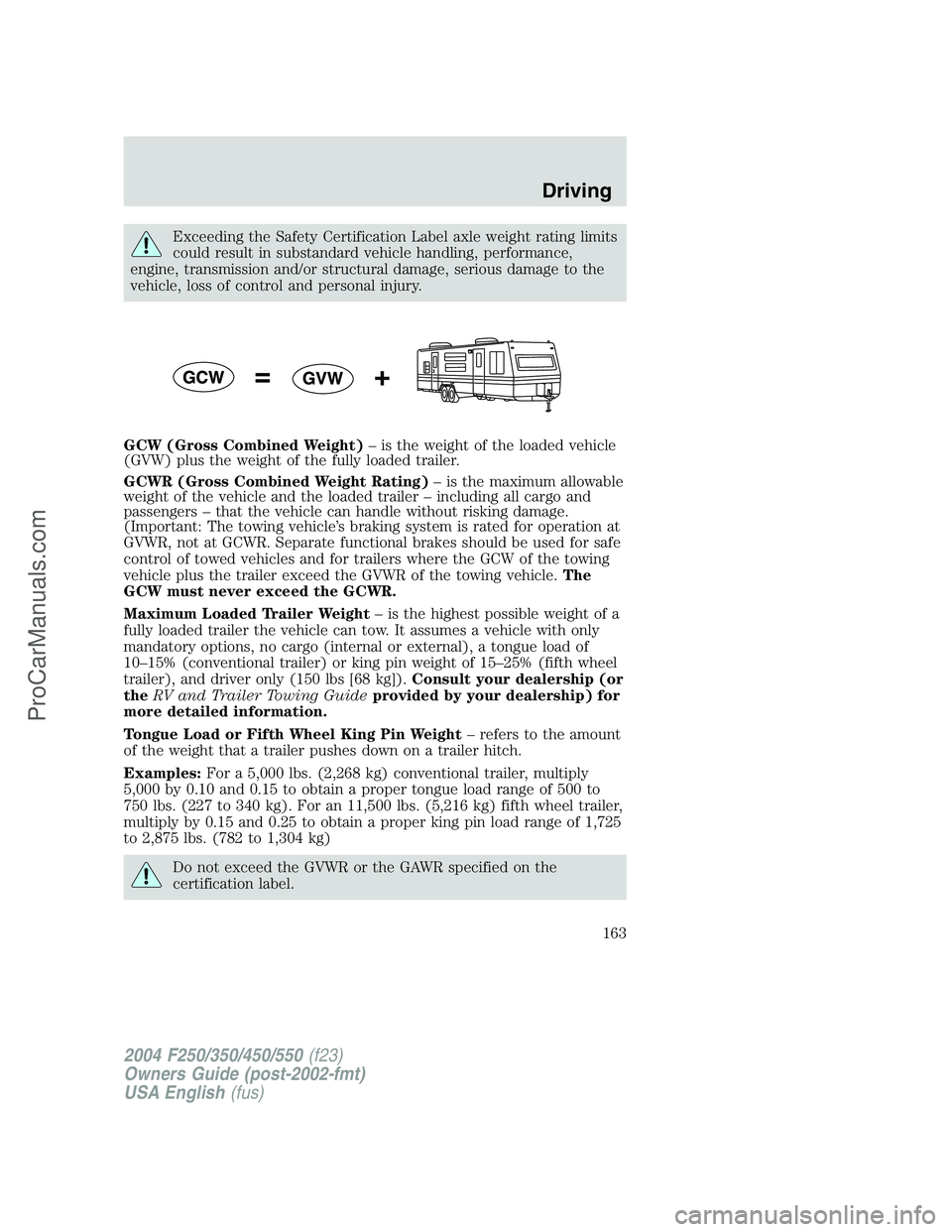
Exceeding the Safety Certification Label axle weight rating limits
could result in substandard vehicle handling, performance,
engine, transmission and/or structural damage, serious damage to the
vehicle, loss of control and personal injury.
GCW (Gross Combined Weight)–is the weight of the loaded vehicle
(GVW) plus the weight of the fully loaded trailer.
GCWR (Gross Combined Weight Rating)–is the maximum allowable
weight of the vehicle and the loaded trailer–including all cargo and
passengers–that the vehicle can handle without risking damage.
(Important: The towing vehicle’s braking system is rated for operation at
GVWR, not at GCWR. Separate functional brakes should be used for safe
control of towed vehicles and for trailers where the GCW of the towing
vehicle plus the trailer exceed the GVWR of the towing vehicle.The
GCW must never exceed the GCWR.
Maximum Loaded Trailer Weight–is the highest possible weight of a
fully loaded trailer the vehicle can tow. It assumes a vehicle with only
mandatory options, no cargo (internal or external), a tongue load of
10–15% (conventional trailer) or king pin weight of 15–25% (fifth wheel
trailer), and driver only (150 lbs [68 kg]).Consult your dealership (or
theRV and Trailer Towing Guideprovided by your dealership) for
more detailed information.
Tongue Load or Fifth Wheel King Pin Weight–refers to the amount
of the weight that a trailer pushes down on a trailer hitch.
Examples:For a 5,000 lbs. (2,268 kg) conventional trailer, multiply
5,000 by 0.10 and 0.15 to obtain a proper tongue load range of 500 to
750 lbs. (227 to 340 kg). For an 11,500 lbs. (5,216 kg) fifth wheel trailer,
multiply by 0.15 and 0.25 to obtain a proper king pin load range of 1,725
to 2,875 lbs. (782 to 1,304 kg)
Do not exceed the GVWR or the GAWR specified on the
certification label.
2004 F250/350/450/550(f23)
Owners Guide (post-2002-fmt)
USA English(fus)
Driving
163
ProCarManuals.com
Page 164 of 312

Do not use replacement tires with lower load carrying capacities
than the originals because they may lower the vehicle’s GVWR
and GAWR limitations. Replacement tires with a higher limit than the
originals do not increase the GVWR and GAWR limitations.
Exceeding any vehicle weight rating limitation could result in
serious damage to the vehicle and/or personal injury.
Special loading instructions for owners of pickup trucks and
utility-type vehicles
For important information regarding safe operation of this type
of vehicle, see thePreparing to drive your vehiclesection in
this chapter.
Loaded vehicles may handle differently than unloaded vehicles.
Extra precautions, such as slower speeds and increased stopping
distance, should be taken when driving a heavily loaded vehicle.
Your vehicle can haul more cargo and people than most passenger cars.
Depending upon the type and placement of the load, hauling cargo and
people may raise the center of gravity of the vehicle.
Calculating the load your vehicle can carry/tow
1. Use the appropriate maximum GCWR chart (in theTrailer towing
section in this chapter) for your type of engine and rear axle ratio.
2. Weigh your vehicle without cargo. To obtain correct weights, take your
vehicle to a shipping company or an inspection station for trucks.
3. Subtract your loaded weight from the maximum GCWR in the chart.
This is the maximum trailer weight your vehicle can tow. It must be
below the maximum trailer weight shown in the chart.
TRAILER TOWING
Your vehicle may tow a Conventional/Class IV trailer or fifth wheel trailer
provided the maximum trailer weight is less than or equal to the
maximum trailer weight listed for your engine and rear axle ratio on the
following charts.
2nd unit bodies are not included in maximum trailer weight ratings. The
weight of the additional“body”must be subtracted from the maximum
trailer weight.
2004 F250/350/450/550(f23)
Owners Guide (post-2002-fmt)
USA English(fus)
Driving
164
ProCarManuals.com
Page 165 of 312
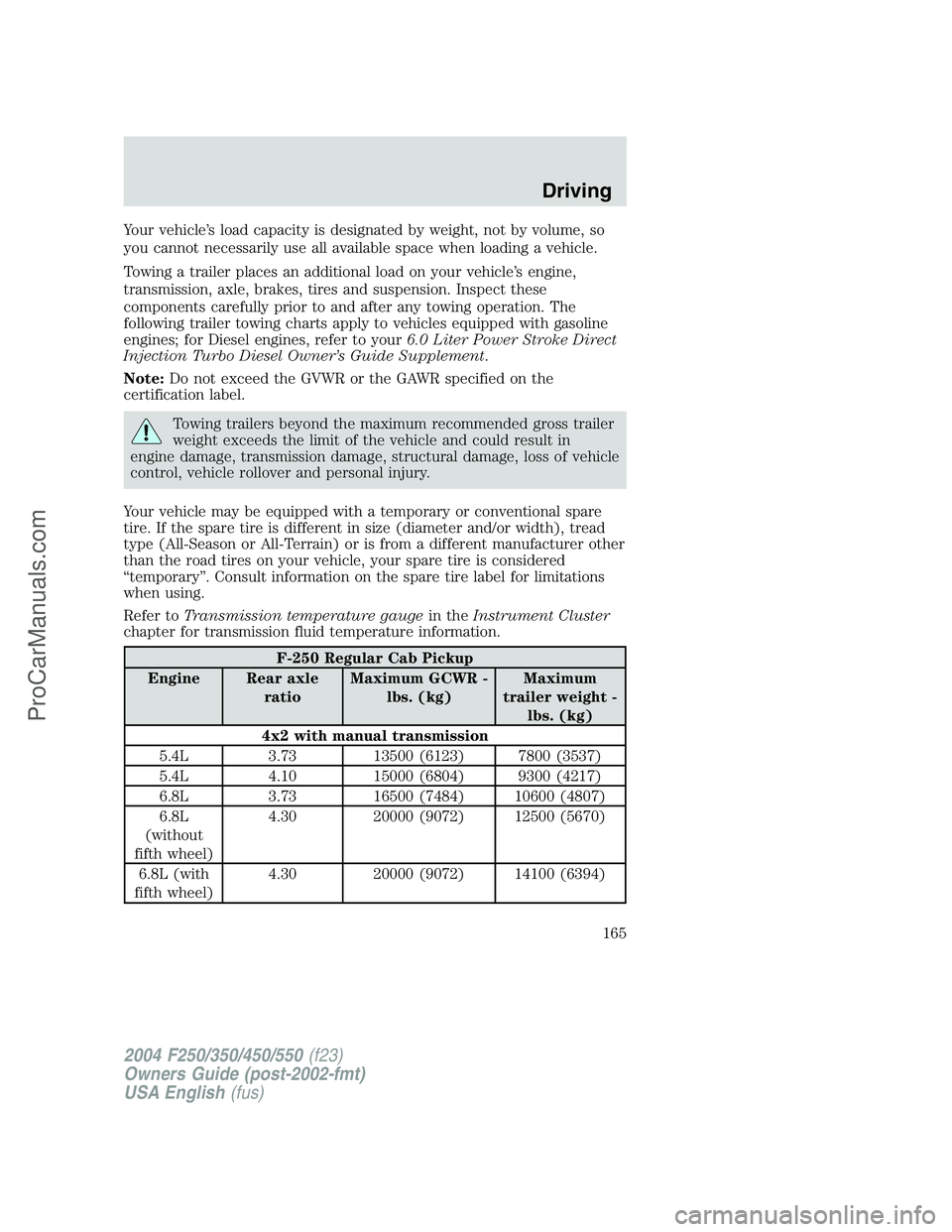
Your vehicle’s load capacity is designated by weight, not by volume, so
you cannot necessarily use all available space when loading a vehicle.
Towing a trailer places an additional load on your vehicle’s engine,
transmission, axle, brakes, tires and suspension. Inspect these
components carefully prior to and after any towing operation. The
following trailer towing charts apply to vehicles equipped with gasoline
engines; for Diesel engines, refer to your6.0 Liter Power Stroke Direct
Injection Turbo Diesel Owner’s Guide Supplement.
Note:Do not exceed the GVWR or the GAWR specified on the
certification label.
Towing trailers beyond the maximum recommended gross trailer
weight exceeds the limit of the vehicle and could result in
engine damage, transmission damage, structural damage, loss of vehicle
control, vehicle rollover and personal injury.
Your vehicle may be equipped with a temporary or conventional spare
tire. If the spare tire is different in size (diameter and/or width), tread
type (All-Season or All-Terrain) or is from a different manufacturer other
than the road tires on your vehicle, your spare tire is considered
“temporary”. Consult information on the spare tire label for limitations
when using.
Refer toTransmission temperature gaugein theInstrument Cluster
chapter for transmission fluid temperature information.
F-250 Regular Cab Pickup
Engine Rear axle
ratioMaximum GCWR -
lbs. (kg)Maximum
trailer weight -
lbs. (kg)
4x2 with manual transmission
5.4L 3.73 13500 (6123) 7800 (3537)
5.4L 4.10 15000 (6804) 9300 (4217)
6.8L 3.73 16500 (7484) 10600 (4807)
6.8L
(without
fifth wheel)4.30 20000 (9072) 12500 (5670)
6.8L (with
fifth wheel)4.30 20000 (9072) 14100 (6394)
2004 F250/350/450/550(f23)
Owners Guide (post-2002-fmt)
USA English(fus)
Driving
165
ProCarManuals.com
Page 166 of 312
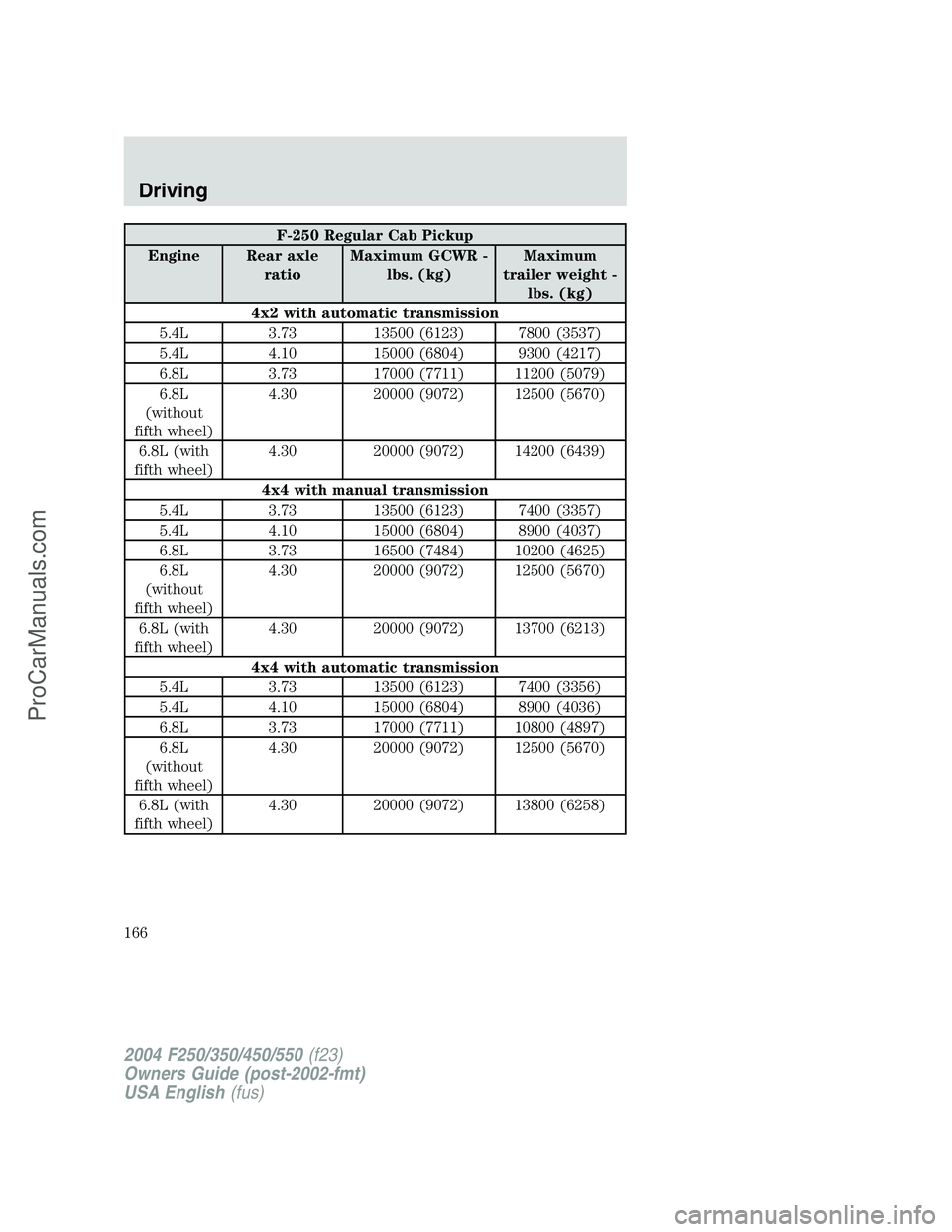
F-250 Regular Cab Pickup
Engine Rear axle
ratioMaximum GCWR -
lbs. (kg)Maximum
trailer weight -
lbs. (kg)
4x2 with automatic transmission
5.4L 3.73 13500 (6123) 7800 (3537)
5.4L 4.10 15000 (6804) 9300 (4217)
6.8L 3.73 17000 (7711) 11200 (5079)
6.8L
(without
fifth wheel)4.30 20000 (9072) 12500 (5670)
6.8L (with
fifth wheel)4.30 20000 (9072) 14200 (6439)
4x4 with manual transmission
5.4L 3.73 13500 (6123) 7400 (3357)
5.4L 4.10 15000 (6804) 8900 (4037)
6.8L 3.73 16500 (7484) 10200 (4625)
6.8L
(without
fifth wheel)4.30 20000 (9072) 12500 (5670)
6.8L (with
fifth wheel)4.30 20000 (9072) 13700 (6213)
4x4 with automatic transmission
5.4L 3.73 13500 (6123) 7400 (3356)
5.4L 4.10 15000 (6804) 8900 (4036)
6.8L 3.73 17000 (7711) 10800 (4897)
6.8L
(without
fifth wheel)4.30 20000 (9072) 12500 (5670)
6.8L (with
fifth wheel)4.30 20000 (9072) 13800 (6258)
2004 F250/350/450/550(f23)
Owners Guide (post-2002-fmt)
USA English(fus)
Driving
166
ProCarManuals.com
Page 167 of 312
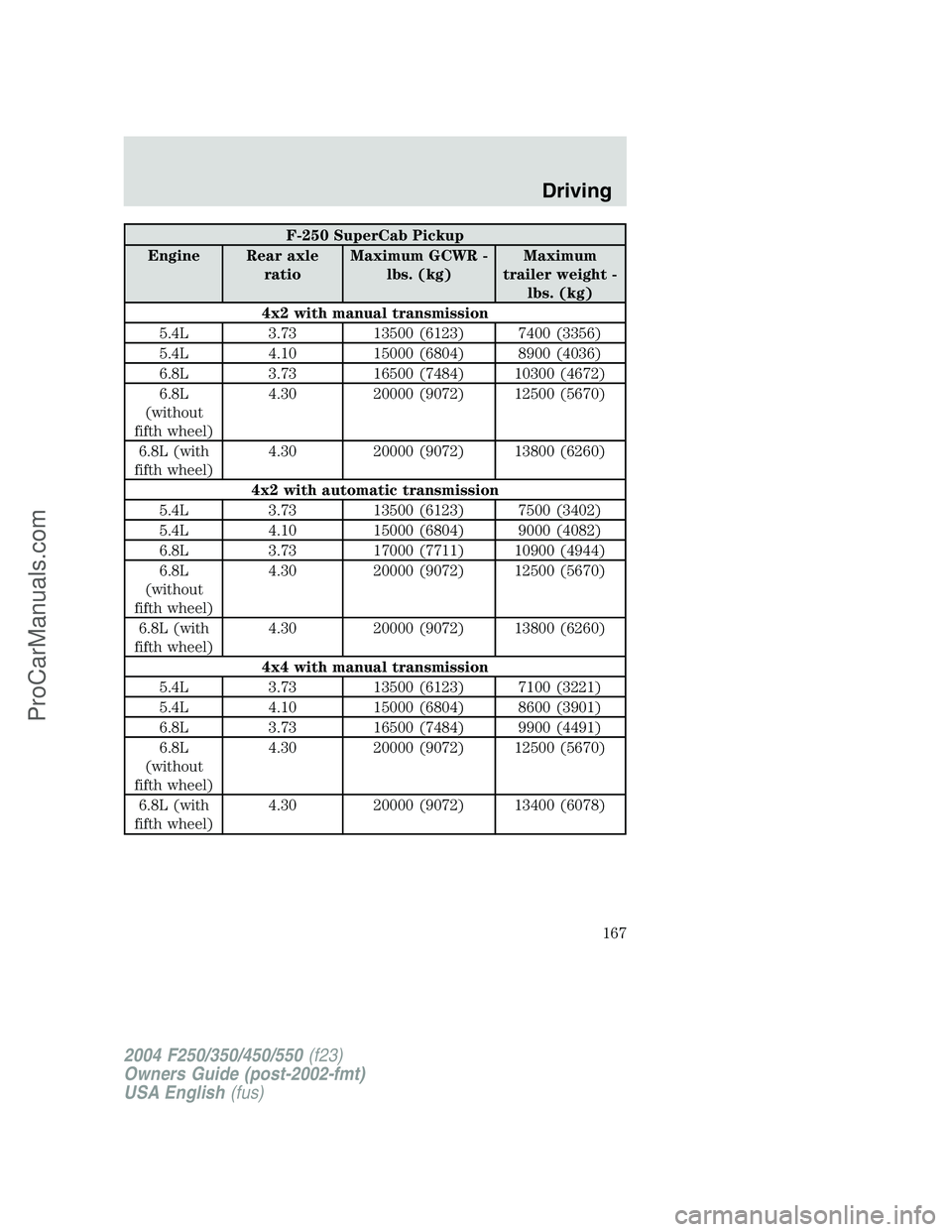
F-250 SuperCab Pickup
Engine Rear axle
ratioMaximum GCWR -
lbs. (kg)Maximum
trailer weight -
lbs. (kg)
4x2 with manual transmission
5.4L 3.73 13500 (6123) 7400 (3356)
5.4L 4.10 15000 (6804) 8900 (4036)
6.8L 3.73 16500 (7484) 10300 (4672)
6.8L
(without
fifth wheel)4.30 20000 (9072) 12500 (5670)
6.8L (with
fifth wheel)4.30 20000 (9072) 13800 (6260)
4x2 with automatic transmission
5.4L 3.73 13500 (6123) 7500 (3402)
5.4L 4.10 15000 (6804) 9000 (4082)
6.8L 3.73 17000 (7711) 10900 (4944)
6.8L
(without
fifth wheel)4.30 20000 (9072) 12500 (5670)
6.8L (with
fifth wheel)4.30 20000 (9072) 13800 (6260)
4x4 with manual transmission
5.4L 3.73 13500 (6123) 7100 (3221)
5.4L 4.10 15000 (6804) 8600 (3901)
6.8L 3.73 16500 (7484) 9900 (4491)
6.8L
(without
fifth wheel)4.30 20000 (9072) 12500 (5670)
6.8L (with
fifth wheel)4.30 20000 (9072) 13400 (6078)
2004 F250/350/450/550(f23)
Owners Guide (post-2002-fmt)
USA English(fus)
Driving
167
ProCarManuals.com
Page 168 of 312
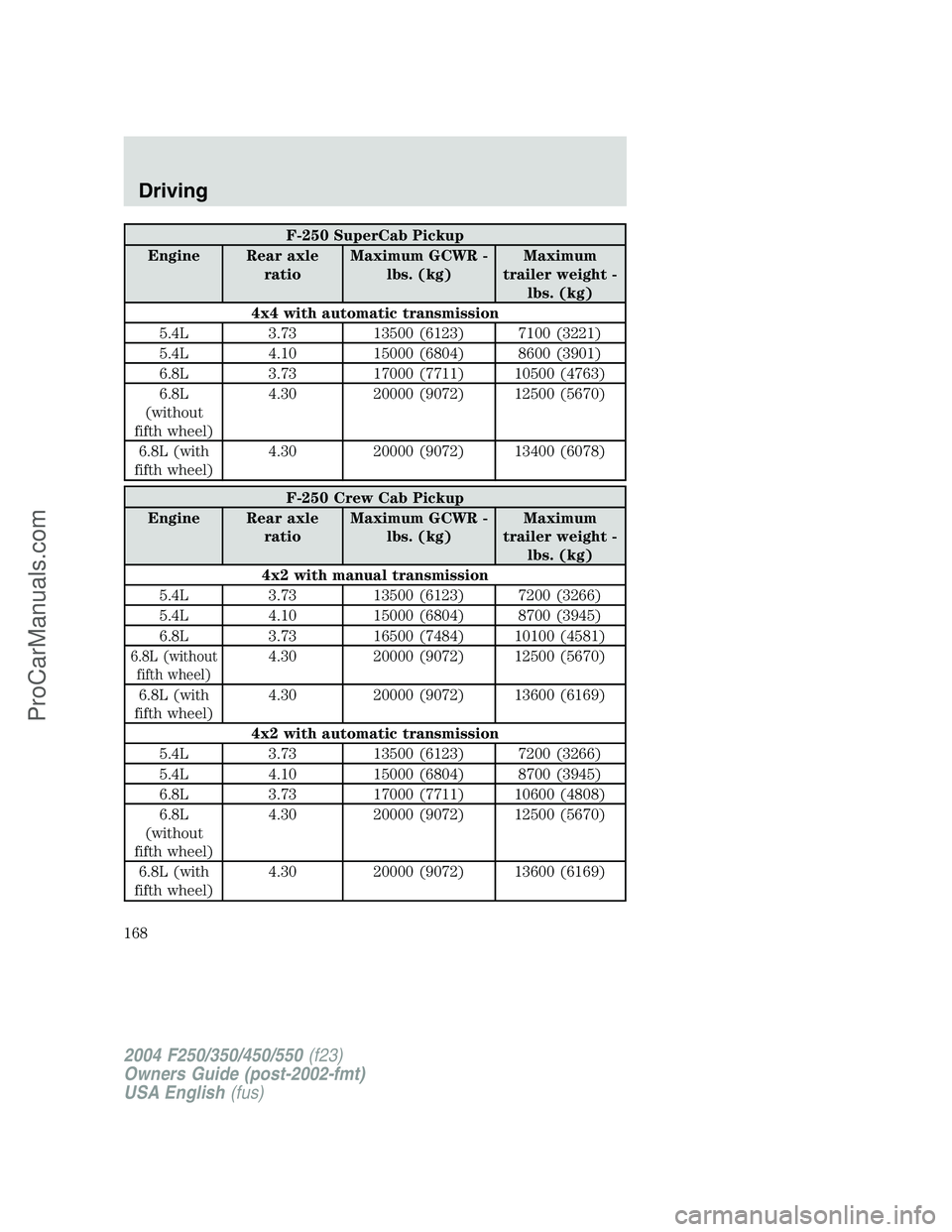
F-250 SuperCab Pickup
Engine Rear axle
ratioMaximum GCWR -
lbs. (kg)Maximum
trailer weight -
lbs. (kg)
4x4 with automatic transmission
5.4L 3.73 13500 (6123) 7100 (3221)
5.4L 4.10 15000 (6804) 8600 (3901)
6.8L 3.73 17000 (7711) 10500 (4763)
6.8L
(without
fifth wheel)4.30 20000 (9072) 12500 (5670)
6.8L (with
fifth wheel)4.30 20000 (9072) 13400 (6078)
F-250 Crew Cab Pickup
Engine Rear axle
ratioMaximum GCWR -
lbs. (kg)Maximum
trailer weight -
lbs. (kg)
4x2 with manual transmission
5.4L 3.73 13500 (6123) 7200 (3266)
5.4L 4.10 15000 (6804) 8700 (3945)
6.8L 3.73 16500 (7484) 10100 (4581)
6.8L (without
fifth wheel)4.30 20000 (9072) 12500 (5670)
6.8L (with
fifth wheel)4.30 20000 (9072) 13600 (6169)
4x2 with automatic transmission
5.4L 3.73 13500 (6123) 7200 (3266)
5.4L 4.10 15000 (6804) 8700 (3945)
6.8L 3.73 17000 (7711) 10600 (4808)
6.8L
(without
fifth wheel)4.30 20000 (9072) 12500 (5670)
6.8L (with
fifth wheel)4.30 20000 (9072) 13600 (6169)
2004 F250/350/450/550(f23)
Owners Guide (post-2002-fmt)
USA English(fus)
Driving
168
ProCarManuals.com
Page 169 of 312
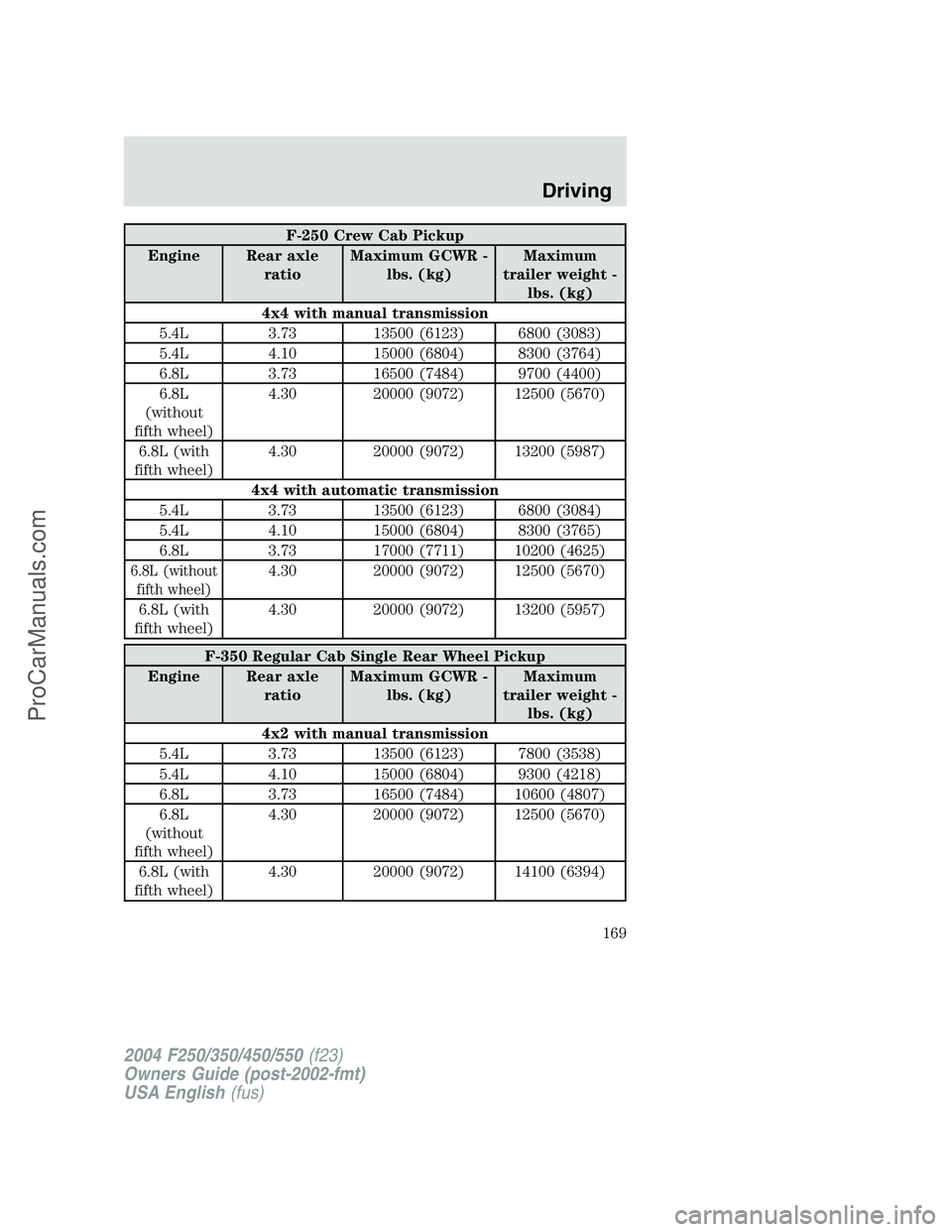
F-250 Crew Cab Pickup
Engine Rear axle
ratioMaximum GCWR -
lbs. (kg)Maximum
trailer weight -
lbs. (kg)
4x4 with manual transmission
5.4L 3.73 13500 (6123) 6800 (3083)
5.4L 4.10 15000 (6804) 8300 (3764)
6.8L 3.73 16500 (7484) 9700 (4400)
6.8L
(without
fifth wheel)4.30 20000 (9072) 12500 (5670)
6.8L (with
fifth wheel)4.30 20000 (9072) 13200 (5987)
4x4 with automatic transmission
5.4L 3.73 13500 (6123) 6800 (3084)
5.4L 4.10 15000 (6804) 8300 (3765)
6.8L 3.73 17000 (7711) 10200 (4625)
6.8L (without
fifth wheel)4.30 20000 (9072) 12500 (5670)
6.8L (with
fifth wheel)4.30 20000 (9072) 13200 (5957)
F-350 Regular Cab Single Rear Wheel Pickup
Engine Rear axle
ratioMaximum GCWR -
lbs. (kg)Maximum
trailer weight -
lbs. (kg)
4x2 with manual transmission
5.4L 3.73 13500 (6123) 7800 (3538)
5.4L 4.10 15000 (6804) 9300 (4218)
6.8L 3.73 16500 (7484) 10600 (4807)
6.8L
(without
fifth wheel)4.30 20000 (9072) 12500 (5670)
6.8L (with
fifth wheel)4.30 20000 (9072) 14100 (6394)
2004 F250/350/450/550(f23)
Owners Guide (post-2002-fmt)
USA English(fus)
Driving
169
ProCarManuals.com
Page 170 of 312
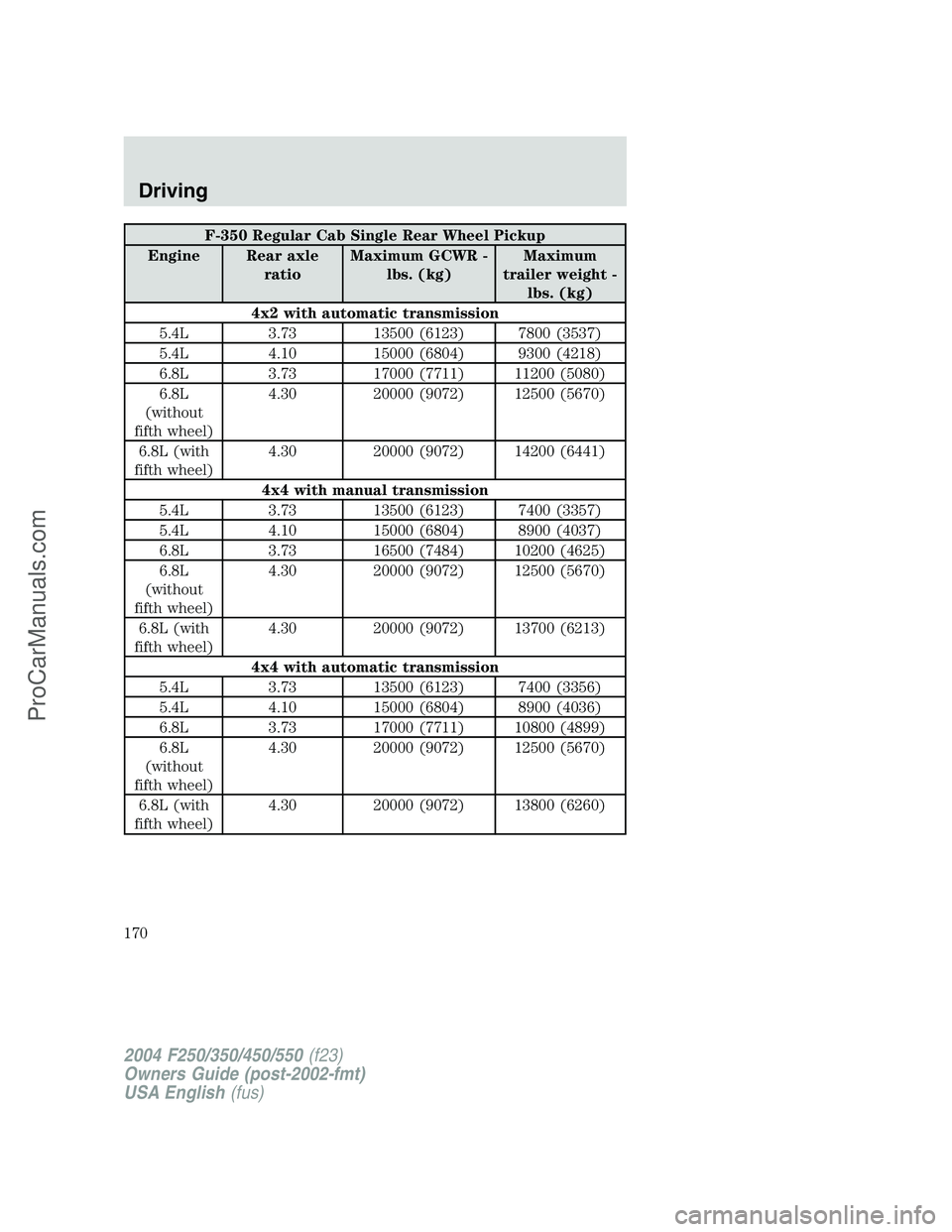
F-350 Regular Cab Single Rear Wheel Pickup
Engine Rear axle
ratioMaximum GCWR -
lbs. (kg)Maximum
trailer weight -
lbs. (kg)
4x2 with automatic transmission
5.4L 3.73 13500 (6123) 7800 (3537)
5.4L 4.10 15000 (6804) 9300 (4218)
6.8L 3.73 17000 (7711) 11200 (5080)
6.8L
(without
fifth wheel)4.30 20000 (9072) 12500 (5670)
6.8L (with
fifth wheel)4.30 20000 (9072) 14200 (6441)
4x4 with manual transmission
5.4L 3.73 13500 (6123) 7400 (3357)
5.4L 4.10 15000 (6804) 8900 (4037)
6.8L 3.73 16500 (7484) 10200 (4625)
6.8L
(without
fifth wheel)4.30 20000 (9072) 12500 (5670)
6.8L (with
fifth wheel)4.30 20000 (9072) 13700 (6213)
4x4 with automatic transmission
5.4L 3.73 13500 (6123) 7400 (3356)
5.4L 4.10 15000 (6804) 8900 (4036)
6.8L 3.73 17000 (7711) 10800 (4899)
6.8L
(without
fifth wheel)4.30 20000 (9072) 12500 (5670)
6.8L (with
fifth wheel)4.30 20000 (9072) 13800 (6260)
2004 F250/350/450/550(f23)
Owners Guide (post-2002-fmt)
USA English(fus)
Driving
170
ProCarManuals.com